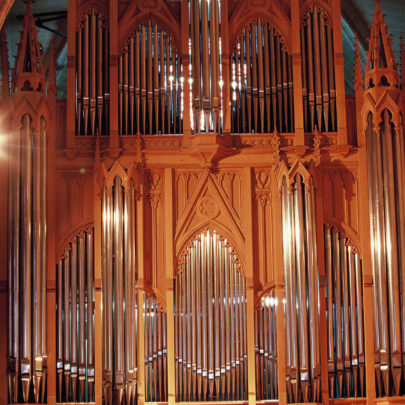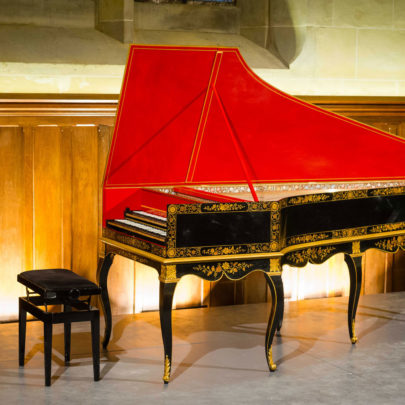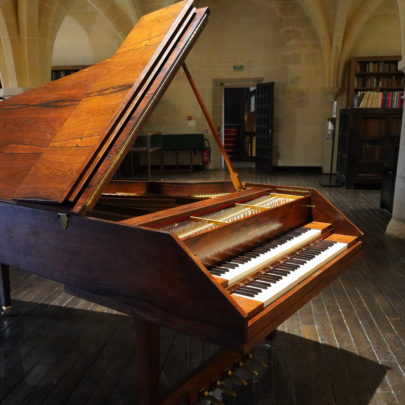The libraries
As part of a strengthened cultural cooperation, the Royaumont Foundation and the La Grange-Fleuret music Library (located in Paris and managed by the Foundation since 2016) have combined their documentary and heritage collections under a single banner called ‘Royaumont Libraries’. This entity comprises the La Grange-Fleuret music Library and the two libraries housed at Royaumont Abbey, the François-Lang music Library (BmFL) and the Henry and Isabel Goüin general Library (BHIG), which bring together a remarkable collection of heritage items.
Thanks to a concerted policy of expanding their collections and sharing expertise, the MMM and the BmFL are developing a programme of activities that combines research and musical practice. The premises they occupy, the conditions of access to the works they offer and the equipment they make available make them unique places dedicated to study and reflection, but also sources of inspiration for artists keen to enrich their knowledge, take a new look at repertoires and renew their interpretation.
The François-Lang music Library (BmFL)
The BmFL has a unique collection of manuscripts and printed music collected by pianist François Lang, brother of Isabel Goüin-Lang. Lang’s collection, in which keyboard music plays an important role, comprises 1,300 titles dating from the late 16th century to the 20th century. It was acquired by the Foundation in 2006.
The BmFL also owns several collectors’ collections (the Rameau/Florentin Collection, the Hameline Collection, the Isoir Collection, etc.).
The La Grange-Fleuret music Library – Paris VIIIe (BLGF)
Founded in 1986 by Maurice Fleuret and Henry-Louis de La Grange, the former Mahler Music Media Library is one of Europe’s leading private collections of 19th- and 20th-century music. An exceptional documentation centre comprising 700 musical manuscripts, the library offers a formidable bibliographic and discographic corpus as well as an archive collection.
In addition to Henry-Louis de La Grange’s remarkable catalogue dedicated to Mahler, there are collections from pianists (Cortot, Long, Lefébure, Helffer) and composers (Rossini, Cras, Ballif, etc.).
The library’s premises on Rue de Vezelay in Paris have undergone a complete renovation and extension.
The Henry et Isabel Goüin general Library (BHIG)
With around 23,000 volumes, the Henry and Isabel Goüin Library is a varied and eclectic collection, resulting from the purchase and donation of private collections (in particular the Paul Desjardins, Jean Cassou and Henri Bergson collections), to which have been added acquisitions related to the activities of the Royaumont Foundation since 1938.
A true ‘honest man’s’ library, it bears witness, along with the associated archival collections, to the richness of Royaumont’s cultural project since its inception.
The instruments
The monks’ refectory at Royaumont Abbey houses a large organ by Aristide Cavaillé-Coll, built in 1864. The instrument was acquired in 1936 by François Lang to inaugurate the first musical season at Royaumont. Listed as a historic monument, it underwent extensive restoration between 2002 and 2007.
Royaumont has other exceptional instruments: a harpsichord by Emile Jobin, a copy of a Vater harpsichord from 1732 classified as a national treasure, and a Romanesque organ designed by Marcel Pérès and Antoine Massoni (†) based on an 11th-century treatise, Théophile’s Tractatus Diversarum Artium.
As for the La Grange-Fleuret Music Library, it received a donation from the La Grange-Fleuret Fund of a 1907 Steinway concert piano. This instrument originally belonged to Princess Winnaretta de Polignac.
Other historic keyboards have been entrusted to the Foundation and are also made available to laureates and artists in residence, promoting practice and transmission.
The instruments

The Cavaillé-Coll organ
It has 2,573 pipes, 2,316 of which are original pipes.

The Roman organ
It consists of fifty-seven copper pipes arranged in three rows.

The Vater harpsichord
A copy of the Vater harpsichord from 1732, classified as a national treasure, which is housed in the Musée de la Musique (Paris).

The Anthony Sidey harpsichord
Its large size, power and robustness allow for percussive and dynamic playing.